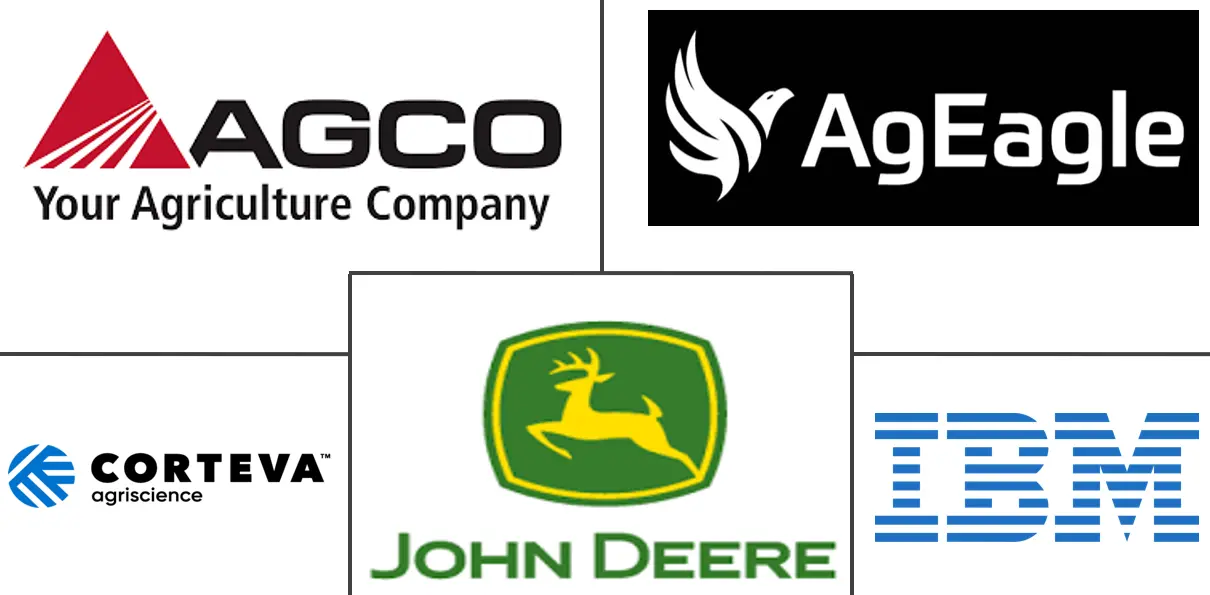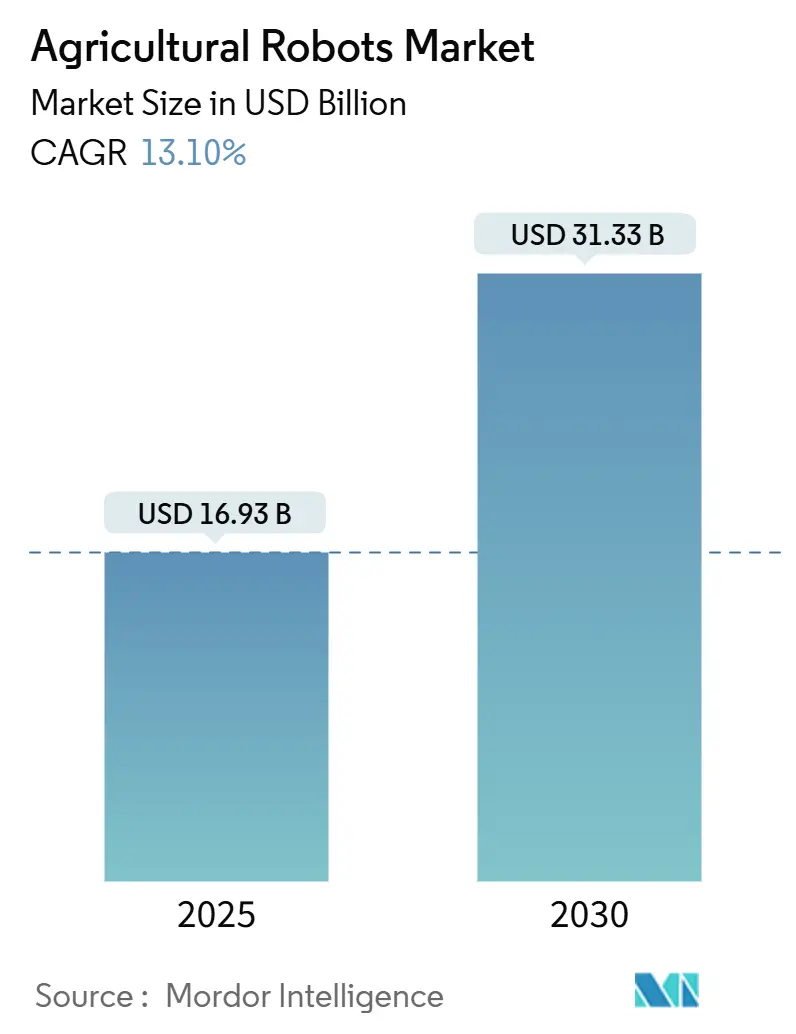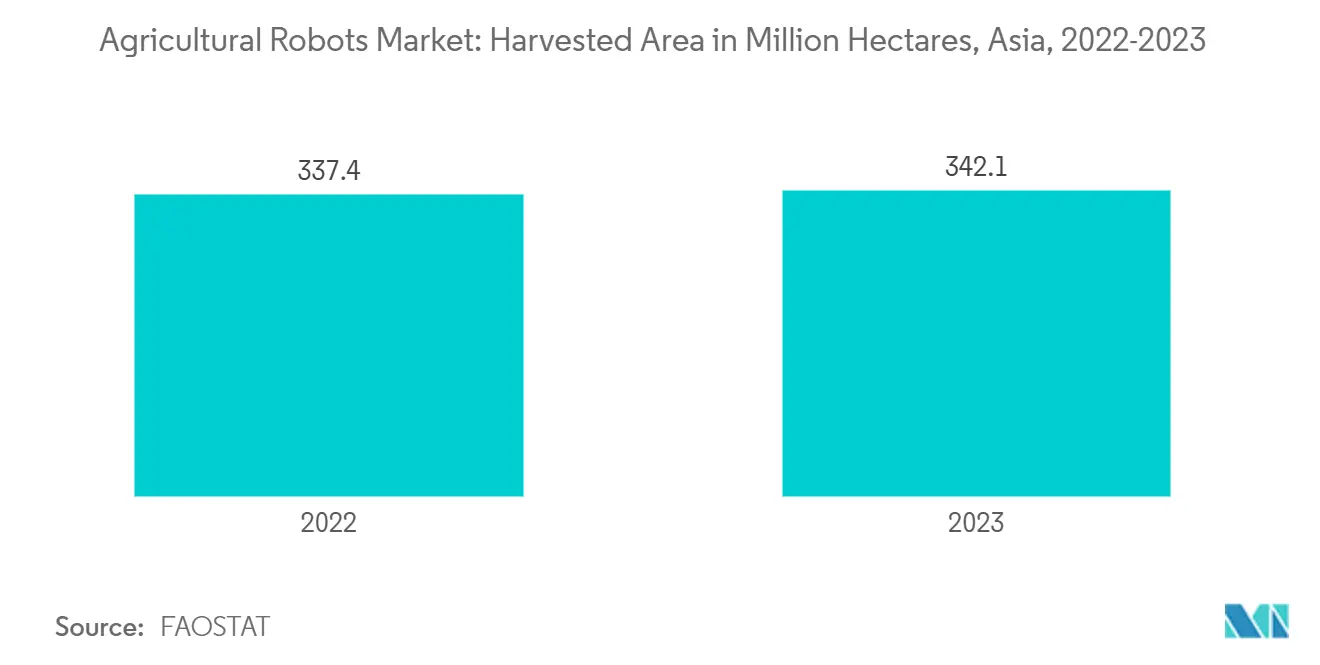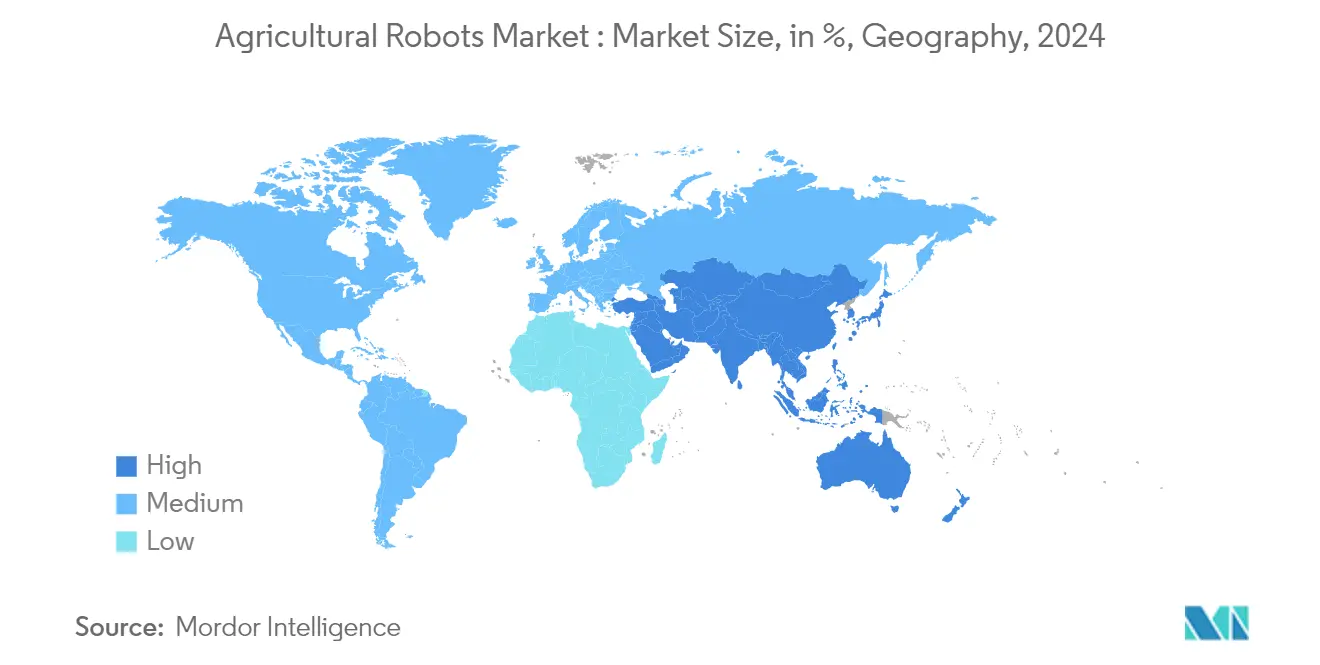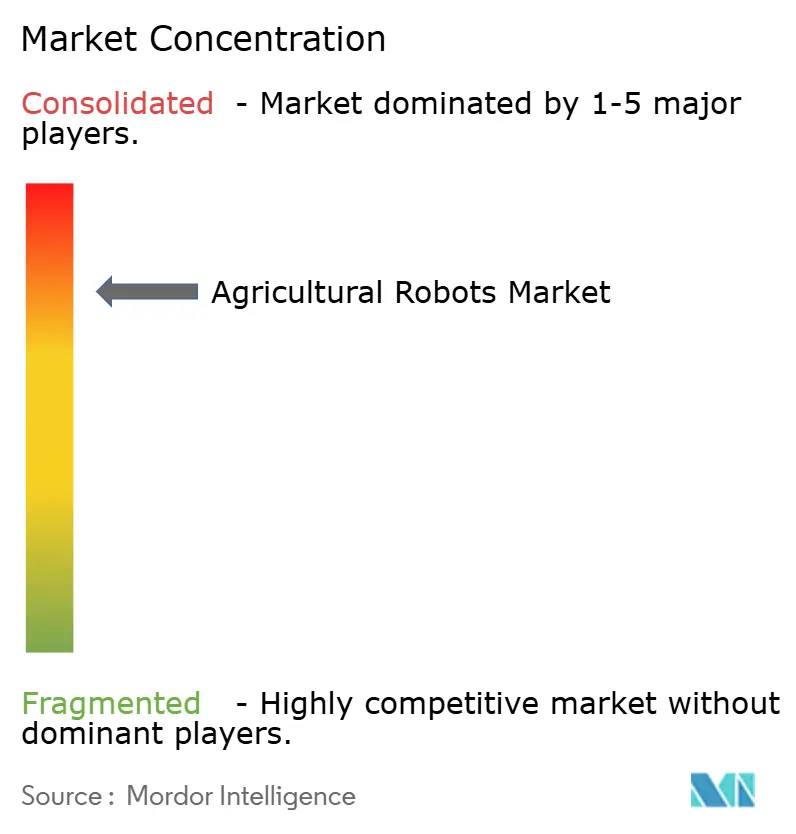Agricultural Robots Market Analysis
The Agricultural Robots Market size is estimated at USD 16.93 billion in 2025, and is expected to reach USD 31.33 billion by 2030, at a CAGR of 13.10% during the forecast period (2025-2030).
Agricultural robots, also known as “agribots”, represent a significant advancement in the agriculture industry. These autonomous machines enhance yield quality, improve efficiency, increase productivity, and reduce manual labor dependency. The United Nations projects a global population of 9.8 billion by 2050, and with limited arable land availability and food security concerns, the agricultural sector is advancing through automation, the Internet of Things (IoT), artificial intelligence, and big data applications. Farmers are increasingly adopting agricultural robots to improve productivity and increase revenue.
The agricultural sector's labor shortage continues to intensify as employment declines. World Bank data shows that agricultural employment in the United States fell to 1.62% of total employment in 2022, a 0.04% decrease from the previous year. This shortage has led to higher wage rates, expanding opportunities in the agricultural robots market. The market shows increasing adoption of driverless tractors equipped with GPS technology for automatic steering, tool operation, farm boundary recognition, and remote tablet operation. Farmers implementing smaller automated tractor fleets can achieve over 10% revenue increase while reducing labor costs.
Governments support agricultural mechanization through machinery financing, equipment assistance, and operator training programs. In March 2022, the Canadian government provided USD 860,000 for agricultural machinery innovation and technology development. This funding supports agricultural technology companies in developing autonomous tractor solutions that reduce waste, decrease labor costs, and improve operational efficiency. Agricultural robots decrease time requirements, labor needs, and production costs while reducing post-harvest losses and increasing crop output and farm income. The agriculture sector's adoption of agricultural robots continues to grow due to labor shortages and population growth, a trend anticipated to persist throughout the forecast period.
Agricultural Robots Market Trends
Driverless Tractors Dominate the Agricultural Robots Market
The agriculture labor force has decreased due to reduced interest in farming and an aging farmer population. As farm laborers decline, farmers face pressure to maintain production levels to meet growing demand for fresh produce. The downward trend in labor availability has led to higher wages, increasing reliance on driverless tractors. The American Farm Bureau Federation (AFBF) reported that 56% of US farms adopted agricultural technology in 2022, with more than half citing labor shortage as the primary reason.
Driverless tractors equipped with systems and sensors collect farm-specific data. Farmers analyze this data to gain insights into farm conditions and make informed decisions about planting, crop management, and harvesting routines. According to FAOSTATS, the harvested area of cereals in Asia increased from 337.4 million hectares in 2022 to 342.1 million hectares in 2023, supporting market growth as labor populations decrease.
Lower HP driverless tractors see high demand in developing countries due to limited farmer disposable income and rising labor costs. The Indian Council of Food and Agriculture (ICFA) projects agricultural workers will decrease by 25.7% by 2050. Small farmland sizes in these regions drive demand for compact autonomous tractors. These tractors offer reduced fuel consumption or electric power usage, minimizing greenhouse gas emissions. Their precision technology optimizes seed distribution, fertilizer application, and water usage. European and North American farmers, operating under strict environmental regulations, adopt these autonomous tractors for organic and small-scale farming.
The integration of moisture sensors and GPS-enabled devices in agriculture supports sustainable and profitable food production, driving demand for driverless tractors. In January 2022, John Deere launched the 8R driverless tractor, featuring six pairs of stereo cameras providing 360-degree obstacle detection and distance calculation. The tractor combines camera data with GPS and other sensor inputs for obstacle avoidance, navigation, and location tracking. The United States Department of Agriculture confirms that GPS yield and soil mapping, along with variable-rate input technology (VRT) applications, help farms assess field conditions and adjust production practices.
Hence, the decline in agricultural workforce and continuous development of autonomous tractors indicates increased sales of driverless tractors during the forecast period.
North America Dominates the Market
North America holds the largest share of the agricultural robots market. The region's market growth is driven by high labor costs, increasing labor shortages, and greater adoption of advanced technology due to high per-capita disposable income. The United States, Canada, and Mexico have experienced significant farm labor shortages. According to a California Farm Bureau survey, over 40% of farmers faced consistent labor shortages in various farm operations over the past five years in United States. World Bank data shows that agricultural employment as a percentage of total employment in the United States, Canada, and Mexico decreased to 1.62%, 1.28%, and 12.64% respectively in 2022, declining by 0.04%, 0.05%, and 0.43% respectively from the previous year. Government support for agricultural robots, including unmanned aerial vehicles and driverless tractors, has contributed to regional market growth.
The United States Department of Agriculture reports that agriculture, food, and related industries contributed 5.6% of the GDP in 2023. Approximately 40% of the country's land serves agricultural purposes, including livestock grazing. The average farm size increased from 446 acres to 463 acres from 2022 to 2023 according to USDA, promoting the adoption of agricultural robots for complex farming operations. In Canada, mechanization of farm practices is primarily guided by the economic principle that the use of automated tools instead of manual labor results in cost and higher yield benefits, which is likely to drive the demand for agricultural robots. Saskatchewan-based Dot Technology Corporation has developed a robotic farm vehicle that performs various fieldwork tasks. The Dot Power Platform driverless tractor can be integrated with different Dot-Ready farm implements, such as planters or sprayers, enabling agricultural operations in western Canadian prairie conditions.
Mexico has witnessed increased adoption of technologically advanced tractors in recent years. The agricultural sector's recovery has been supported by counter-cyclical growth and increased agricultural exports to Central and South America. This recovery has enabled farmers to invest in automation technologies. The combination of addressing labor shortages and introducing products tailored to farmers' needs continues to drive the agricultural robots market growth across North America.
Agricultural Robots Industry Overview
The agricultural robot market is consolidated with active players competing on the basis of product quality and promotion and focusing on their strategic moves to hold larger market shares. Companies are investing heavily to develop new and cost-efficient products. They are also collaborating with and acquiring other companies to increase their market shares and strengthen R&D activities. The companies like AGCO Corporation, Deere & Company, IBM Corporation, AG Eagle LLC, and Corteva Agriscience (Granular, Inc.) are some of the major players in the agricultural robots market.
Agricultural Robots Market Leaders
-
Deere & Company
-
AGCO Corporation
-
AG Eagle LLC
-
Corteva Agriscience (Granular, Inc.)
-
IBM Corporation
- *Disclaimer: Major Players sorted in no particular order
Agricultural Robots Market News
- March 2024: New Holland, a CNH brand, partnered with Bluewhite, an AI-driven autonomous farming technology company, to enhance autonomous capabilities of New Holland tractors in North America. The multi-year partnership integrates Bluewhite's autonomous solutions into New Holland's tractor range, focusing on specialty crop operations in orchards and vineyards. The partnership aims to expand regionally and globally to increase customer access to CNH's solutions.
- February 2024: John Deere, in collaboration with GUSS Automation, introduced the Electric GUSS, the first fully electric autonomous herbicide orchard sprayer in the industry. The system enables farmers to control multiple sprayers from a remote location, improving productivity and reducing labor requirements.
- March 2023: DeLaval introduced the OptiWagon, a component of its DeLaval Optimat automated feeding system, to improve feeding efficiency in dairy farms. The system comes in Standard and Master versions, accommodating farms with 120 to 1,000 cows, and is available in most European markets.
- June 2022: Small Robot Company (SRC), a British agriculture robotics startup, announced plans to launch its agricultural robots at around 50 farms over the course of the 2022-2023 growing season.
Agricultural Robots Industry Segmentation
Agricultural robots are specialized articles of technology that are capable of assisting farmers with a wide range of operations for improving the quality and efficiency of yield, minimizing reliance on manual labor, and increasing overall productivity. They can analyze, contemplate, and carry out a multitude of functions. The Agricultural Robots Market is segmented by Type (Unmanned Aerial Vehicles (Drones), Milking Robots, Driverless Tractors, and Automated Harvesting Systems), Application (Broad Acre Applications, Dairy Farm Management, Aerial Data Collection, Weather Tracking and Forecasting, and Inventory Management), Offering (Hardware, Software, and Services), and Geography (North America, Europe, Asia-Pacific, South America, and Africa). The report offers market size and forecasts in value (USD) for all the above segments.
| Type | Unmanned Aerial Vehicles (Drones) | ||
| Milking Robots | |||
| Driverless Tractors | |||
| Automated Harvesting Systems | |||
| Application | Broad Acre Applications | Field Mapping | |
| Seeding and Planting | |||
| Fertilizing and Irrigation | |||
| Intercultural Operations | |||
| Picking and Harvesting | |||
| Dairy Farm Management | Milking | ||
| Shepherding and Herding | |||
| Aerial Data Collection | |||
| Weather Tracking and Forecasting | |||
| Inventory Management | |||
| Offering | Hardware | ||
| Software | |||
| Services | |||
| Geography | North America | United States | |
| Canada | |||
| Mexico | |||
| Rest of North America | |||
| Europe | Germany | ||
| United Kingdom | |||
| France | |||
| Spain | |||
| Italy | |||
| Rest of Europe | |||
| Asia-Pacific | China | ||
| Japan | |||
| India | |||
| Australia | |||
| Rest of Asia-Pacific | |||
| South America | Brazil | ||
| Argentina | |||
| Rest of South America | |||
| Africa | South Africa | ||
| Rest of Africa | |||
Agricultural Robots Market Research Faqs
How big is the Agricultural Robots Market?
The Agricultural Robots Market size is expected to reach USD 16.93 billion in 2025 and grow at a CAGR of 13.10% to reach USD 31.33 billion by 2030.
What is the current Agricultural Robots Market size?
In 2025, the Agricultural Robots Market size is expected to reach USD 16.93 billion.
Who are the key players in Agricultural Robots Market?
Deere & Company, AGCO Corporation, AG Eagle LLC, Corteva Agriscience (Granular, Inc.) and IBM Corporation are the major companies operating in the Agricultural Robots Market.
Which is the fastest growing region in Agricultural Robots Market?
Europe is estimated to grow at the highest CAGR over the forecast period (2025-2030).
Which region has the biggest share in Agricultural Robots Market?
In 2025, the North America accounts for the largest market share in Agricultural Robots Market.
What years does this Agricultural Robots Market cover, and what was the market size in 2024?
In 2024, the Agricultural Robots Market size was estimated at USD 14.71 billion. The report covers the Agricultural Robots Market historical market size for years: 2019, 2020, 2021, 2022, 2023 and 2024. The report also forecasts the Agricultural Robots Market size for years: 2025, 2026, 2027, 2028, 2029 and 2030.
Our Best Selling Reports
Agricultural Robots Industry Report
The global agriculture robots market is on an upward trajectory, expected to grow at a robust CAGR over the next decade, driven by the increasing global food demand and a shift toward high-efficiency robotic technologies. These advances aim to boost yield and revenue through diverse machines that enhance productivity and reduce labor dependence, including unmanned aerial vehicles and milking robots. The market, segmented by product type, application, and region, is experiencing notable growth, especially in precision agriculture applications, which emphasize sustainability and efficiency. North America leads in market share due to substantial technological and investment advancements, while the Asia-Pacific region displays strong growth due to rapid urbanization and adoption of advanced farming technologies. Despite challenges like high initial costs and data privacy concerns, ongoing innovations aimed at addressing labor shortages and improving crop management are likely to continue propelling substantial market growth. For detailed insights into the agriculture robots market share and growth, and forecasts, a comprehensive analysis is available for free download from Mordor Intelligence™.

